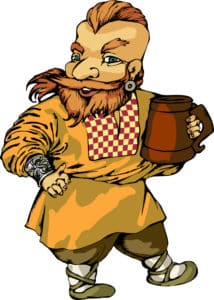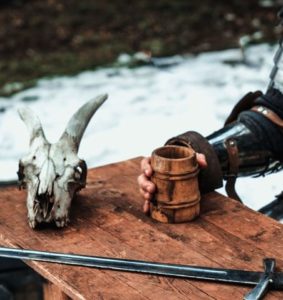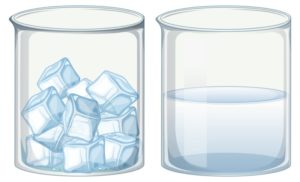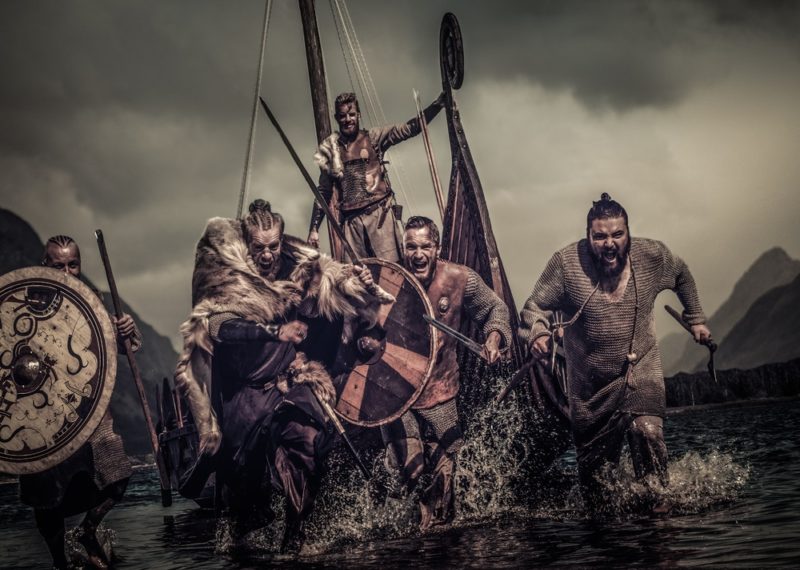The Vikings were a powerful nation that arose from northern Europe and spread across the continent via sheer strength. They ruled over much of Europe and other regions during the Middle Ages. Their preferred alcoholic drinks were beer, ale, and mead, but what vessels did the Norse drink out of?
Vikings frequently drank from animal horns, known as drinking horns crafted to carry their preferred beverages. Drinking vessels might have been made of clay, and wood and glass beakers were used by those who could afford them.

Keep reading if you are hoping to find out more about the Viking mug, drinking horn, horn tankard, and other drinking vessels used by the Norse.
A Symbol of Status
There were several different drinking vessels in use during the Viking age. The Norse were focused on diversity when it came to drinking vessels. Horns, wooden or clay mugs, and even glass beakers were utilized. The Norse would decorate or adorn the cups they drank from to reflect their social standing.
This implies that you could determine their social status by observing what individuals drank from. An affluent Viking’s mug or drinking horn could have been crafted from silver, but the impoverished had to make do with wooden cups.
The Most Common Drinking Vessels Used in the Viking Age
Learning about Viking mugs gives us a fascinating insight into the culture and diversity of the Norse. The sections below discuss some of the most commonly used drinking vessels in the Viking era.

The Drinking Horn
The most well-known and emblematic drinking horns in Viking culture were bovine and auroch horns. Every drinking horn from the medieval era was regarded as a significant part of any home, especially during celebrations and momentous occasions. Several examinations of ancient drinking horns uncovered horns with various embellishments.
Wooden Cups
Wood was a widely available resource, so, understandably, the Norse chose wood to create drinking vessels. Some were regarded as a symbol of prestige polished, unusual designs and patterns, while others were merely everyday kitchenware.
Steatite Mugs
Soapstone was the Norse term for steatite. Steatite mugs were extremely rare, with only a few discovered throughout history. People living in what is now recognized as Trndelag, Norway, used this form of pottery (a thriving region during the Viking Age). Due to their scarcity, steatite mugs were most likely utilized on rare occasions such as banquets and ceremonies.
Ceramic Mugs
The ceramic mug was fashioned using processed clay and was a type of pottery. Because of its lower thermal resistance, it was popular during the Viking era. However, these ceramic mugs were rarely used, especially at major events and gatherings, because they often broke easily.
Glass Beakers
During the Viking era, glass mugs or beakers were considered the most renowned and expensive drinking cups. Wealthy upper-classmen were the most common users of these vessels. These vessels were precious, and a single glass cup could cost a customer more than a year’s wages.
As per archeology research, there are only a few remnants of native glassworking evidence in Norway. This indicates that they were most likely imported from other parts of Europe or the United Kingdom. Some of the glass mugs could be utilized for a relatively long time due to the exceptional care they were given.
Final Thoughts
While Viking mugs are certainly not the latest news, as they have been around for many years, they are still sought after by Viking enthusiasts around the world. The Norse enjoyed drinking their favorite drinks, which were beer, mead, and ale, from drinking horns, glass beakers, and wooden mugs. You can enjoy beer the way the Norse did by adding a Viking mug to your shopping cart!
Frequently Asked Questions
We answer some of the most asked questions about the Viking mug in the section below.
1. Are Viking Mugs Still Used Today?
The truth is that Viking mugs are popular today amongst Viking enthusiasts. Traditional drinking horns are still available, and many come with a stand, so you can set them down.
Unlike in the Viking Age, a customer can visit an online store, shop from a wide range of Viking drinking vessels, adding the items they want to their shopping cart, close cart, and pay using their Apple Pay Diners Club Card or Venmo Visa Credit Card.
The retailer will then deliver the order to the customer. You can also get special discounts on a horn tankard or drinking horn from several online retailers, so be sure to shop around.
While Viking mugs are often used primarily as accessories today and make the perfect gift, they had an essential functional role in the Viking Age. Today, the world enjoys partaking in the Viking culture by purchasing these Viking-inspired drinking vessels.
2. Why Did the Vikings Use Different Types of Drinking Vessels?
The Norse were a warrior nation, as we would describe it today. Because there were no centralized ruling bodies or monarchy in the Viking era, they constantly battled amongst themselves for land, resources, and dominance.
Each Viking settlement had a leader who reigned over his people, but he also regularly invaded neighboring communities.
As a result, drinking vessels came in various forms, depending on the community or location they came from.
3. What Is a Horn Tankard?
Manufacturers have designed what we call a horn tankard. A horn tankard is essentially a modern version of a drinking horn. Manufacturers take a drinking horn and remove its tip. One end is then sealed off to form a cup, and a handle is added on one side.






